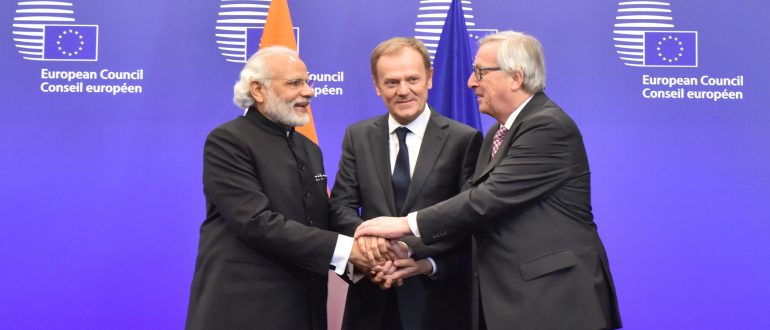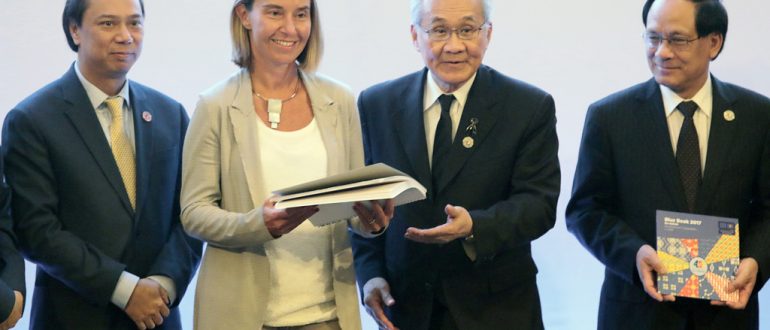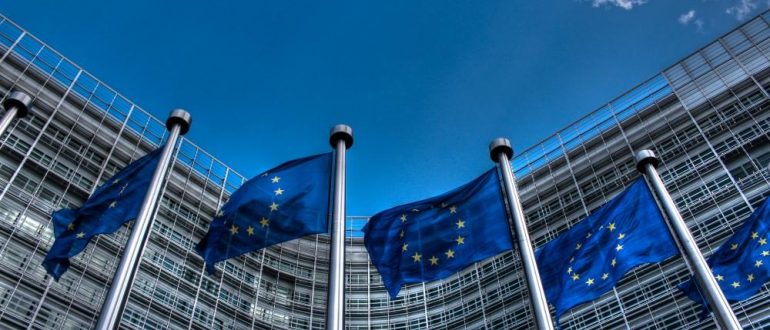China and India – New Kids on the Bloc
China and India are often called emerging powers or the ‘new kids on the block’ in Africa. The question of this article will be to which extent this is an accurate description of their engagement with African countries. To investigate this question not only the historical engagement of these two countries is taken into consideration, but also the comparison to other important actors in Africa like the USA and Europe.
1. Introduction
It is obvious that the new influence of China and India did not come overnight but as a process during a specific time period. Especially since the beginning of the 21st century the emerging role of China and India and their foreign policy is debated in the international arena. As a consequence this article will investigate in which way empirical data and studies approve the assumption of China and India as new central actors in Africa. In this context one central aspect will also be the comparison of the power and influence in Africa by Europe and the USA on the one hand and China and India on the other. To prove the assumption that China and India are emerging powers and new kids on the bloc in Africa, the following two questions have to be answered. Firstly, can we observe a significant qualitative new interest and influence of China and India in Africa in the 21st century and secondly, as a consequence, is this new engagement and influence still notable if we compare it to the influence of Europe and the US? If both questions are answered in the affirmative, we can also approve the assumption that emerging power or new kids on the bloc is an accurate description of China’s and India’s engagement in Africa. For the investigation of the two central questions this article will take into consideration economic data as well as political power shifts.
2. China’s and India’s performance in Africa
The Economic Advisor for the African Region at the World Bank, Harry G. Broadman, describes the role and the recent engagement as follows:
“Economic activity between Africa and Asia is booming like never before. Business between the two continents is not new: India´s trade with Africa´s eastern and southern regions dates back at least to the days of the Silk Road, and China has been involved on the continent since it started investing there, mostly in infrastructure, during the postcolonial era. But today, partly as a result of a accelerating commerce between developing countries throughout the world, the scale and pace of trade and investment flows between Africa and India and China are exceptional” (Broadmann 2008: 95).
In consideration of the fact that both players China and India are historically entangled in Africa, the question could be asked to which extent a perception as new kids on the bloc is still warrantable. However, the author points out an exceptional new scale and pace of trade and investment, which justifies a qualitative new perception as new actors. This significant shift can also be backed up by the export and import progression between India and China and Africa. India’s import from Africa during 1990-2004 has risen at an annual average growth rate of 14%, between 1997 and 2005 it doubled. A quite similar picture can be drawn about China’s import from Africa. The average growth rate between 1990 and 2004 was 20% annually in average and between 1999 and 2004 it rose by 48%. India’s export rate to Africa increased by 182% from 0.95 billion in 1996 to 2.7 billion dollars in 2005. A tremendous increase of 712% has also been achieved for China’s export to Africa from US $ 895 million in 1996 to US $ 9,42 billion in 2005 (cf. Vidayarthee 2009: 194). The import as well as the export development reveals a significant upward shift since the beginning of the 21st century. The new attention to Africa for the case of India is also pointed out by the Research Director of the “Emerging powers in Africa project” Sanusha Naidu:
“India’s evolving engagements across the continent is captured through its increasing trade relations with Africa. While some analysts perceive India as sleepwalking in Africa, especially in terms of its trade partnership, signs are that Delhi is awakening to the reality that Africa is a strategic market. India-Africa trade has jumped from US$967m in 1991 to over US$9.5 bn in 2005” (Naidu 2008: 120).
These remarks back up the assumption for a significant new orientation towards the bloc of Africa. For the case of China there are several other criteria beside the trade rate, which underline its engagement as a new player in Africa. Chinese Foreign Direct Investment grew from $ 20 million in 1998 to $ 6 billion in 2005; Chinese aid to Africa has increased from $ 107 million in 1998 to $ 2.7 billion in 2004. Further, China has canceled bilateral debts from 31 African countries in 2004 and the Chinese government in 2006 passed a policy to encourage and support investment in Africa including the provision of preferential loans and buyer credits (cf. Vidayarthee 2009: 197). Beside the notable increase of aid and foreign direct investment the last two remarks clarify strategic Chinese interests in a long-term economic trade entanglement in Africa.
However, the question remains in which way these inputs of China and India are still remarkable in comparison to the engagement of Europe and the US. The following diagrams give a good overview about the proportional relevance of Western and Asian trade for Africa’s economies (cf. Broadman 2007: 71).
Figure 1: Growth and Proportional Change in Africa’s Export Destination (1990-2005)
Figure 2: Growth and Proportional Change in Africa’s Import Origins (1990-2005)
The impressive growth of Africa’s exports to Asia has surpassed that to all other regions during the last decade. Especially Figure 1 concerning the export destinations of African goods backs up the assumption that China and India became significant new players in Africa. While Asia as export destination region played a comparably marginal role for the export economy in Africa with 9% in 1990, by 2005 Asia’s relative share reached 27%, a value which is comparable to the percentages of Europe and the US.
An enormous increase can also be observed for the import share from Asia (cf. Figure 2) with an increase from 23% in 1990 to 33% in 2005. Regarding the import share, Asia is the only continent with an increase between 1990 and 2005, while the percentage of imports from the USA and Europe accordingly decreased.
3. Conclusion
Looking back at the two central questions we can consider that concerning the first, and especially from an economic point of view, China’s and India’s interaction with Africa can be identified as a significantly and qualitatively new interest in and influence for the region. The second question can be answered positive as well: The influence is still significant in comparison to Europe and the US as shown above. As consequence we can identify China and India as the new kids on the bloc in Africa. The interesting question will be in which way these new kids will influence the bloc. A lot of studies and media articles especially from Europe and the US question a positive influence on Africa and criticize a deficient orientation on democracy and good governance criteria in the policy of the new kids. A threat is illustrated especially in the case of China about the non-consideration of dictatorial regimes and human-rights violence in the context of its economic activities. Furthermore some critics even speak of a “New Scramble” across the continent for resource extraction. They assume that the influence of China and India finally leads to a more underdeveloped African region. The typical rhetoric is well illustrated by the following quote of Uche Ewelukwa Ofodile, Professor at the Arkansas University:
“Reports published by U.S.-based think thanks point to an ongoing scramble for Africa´s resources. These reports typically announce China´s recent foray into Africa with alarm and trepidation, suggest that China is motivated by less-than-humanitarian ideals, and charge that China´s involvement will likely undermine human rights and governance in Africa- ideals that Western presumably, are trying to institute on the continent. The reports usually conclude with calls for a revised U.S. strategy in Africa” (Ofodile 2008: 40)
We do not have to discuss that India and especially China are highly interested in African raw materials, but I do not see in this context the huge difference to interests of the West. Somehow or other, finding a sustainable solution by dealing with its raw materials will be one of the central determinate for Africa’s future. Nevertheless progress to a certain degree can be observed for the African continent in the first decade of the 21st century, which increased parallel with the notable new trading patterns with China and India. There are several studies of institutions like the United Nations, the World Bank or the Economic Commission of Africa (cf. UN 2007, World Bank 2007, ECA 2008), which approve Africa a quite good performance not only in the economic sector, but also for the establishment of more political freedom, improvements in the health sector and especially for huge progress in the important sector of education in the first decade of the 21st century. To which extent these improvements can be explained by the new kids on the bloc, by a more considerate acting of the West or maybe by a fundamental new behavior by Africa itself can only be speculated. Somehow or other the bloc rule system has definitely changed. The new kids offer new opportunities as well as new threats for Africa. It will not be advisable for Africa just to absorb all the budding possibilities which are offered from the new kids, but nevertheless it gives Africa a qualitative new opportunity of choosing. This – especially taking into consideration the obvious poor performance of the old kids in the past – can be seen as a fundamental new condition for Africa to develop a more self-defined rule system for their own bloc. So maybe one day Africa will define the rule system for the old as well as the new kids on the bloc.
Ole Engel
Ole Engel is research associate at the “Institut für Erziehungswissenschaften der Humboldt Universität zu Berlin”. He has completed the European Master Global Studies at the Universities of Leipzig, Stellenbosch (South Africa) and Wroclaw (Polen).
List of Figures
Figure 1: Broadman, H., 2007, p. 71.
Figure 2: Broadman, H., 2007, p. 71.
Bibliography
Berger, B., 2006. China’s Engagement in Africa: Can the EU sit back? South African Journal of International Affairs, 13[1], pp. 115-127.
Broadman, H., 2007. Africa´s Silk Road: China and India´s New Economic Frontier. Washington D.C.: World Bank Publication. [pdf] Available at: <http://siteresources.worldbank.org/INTAFROFFCHIECO/Resources/Africas_Silk_Road_09_24_06.pdf> [Accessed: 26 January 2012].
Broadman, H., 2008. China and India go to Africa – New Deals in the Developing World. Foreign Affairs 87[2], pp. 95-109.
Campbell, H., 2007. China in Africa: Challenging US Global Hegemony. In: F. Manji and S. Marks (eds). African Perspectives on China in Africa. Oxford/Nairobi: Fahamu, pp.119-137.
Economic Commission for Africa (ECA) 2008. Sustainable Development Report for Africa. Addis Ababa: ECA Publications and Conference Management Section.
Goldstein, A., 2006. China and India: What´s in it for Africa? Paris: OECD Development Centre. [pdf] Available at: <http://www.oecd.org/dataoecd/2/14/36259343.pdf> [Accessed: 26 January 2012].
Lymann, P. 2006. China´s involvement in Africa: A view from the US. South African Journal of International Affairs, 13[1], pp. 129-138.
Naidu, S. 2008. India´s Growing African Strategy, Review of African Political Economy, 35[1], pp. 116-128.
Mc Cormick, D., 2008. China & India as Africa´s New Donors: The Impact of Aid on Development. Review of African Political Economy, 35[115], pp.73-92.
Ofodile, U. (2008), “Trade, Empires and Subjects – China-Africa Trade: A New Fair Trade Agreement, or the Third Scramble for Africa?” Vanderbilt Journal of Transnational Law, 41, pp. 505-583.
Pham, P., 2007. India´s expanding relations with Africa and their implications for U.S. interests. American Foreign Policy Interests, 29[5], pp. 341-352.
The Economist 2000: Hopeless Africa. Anonymous. London: May 13, 355[8170], p. 17.
The Economist 2008: Africa: There is hope. Anonymous. London: October 11, 389(8601). [online] Available at: <http://www.economist.com/node/12381162> [Accessed 26 January 2012].
United Nations (UN) 2007. The Millenium Development Goals Report 2007. New York: United Nations Department of Economic and Social Affairs (DESA). [pdf] Available at: <http://www.un.org/millenniumgoals/pdf/mdg2007.pdf> [Accessed: 26 January 2012]
Vidayarthee, K., 2009. India´s Trade Engagements with Africa: A comparison with China, India Economy Review, pp. 192-198. [pdf] Available at: <http://vidyarthee.com/Documents/Kaushal%20K%20Vidyarthee.pdf> [Accessed: 26 January 2012].
World Bank 2007. A Decade of Measuring the Quality of Governance: Governance Matters 2007- Worldwide Governance Indicators, 1996 to 2006. Washington D.C.: World Bank Publications. [pdf] Available at: <http://siteresources.worldbank.org/NEWS/Resources/wbi2007-report.pdf> [Accessed: 26 January 2012].



